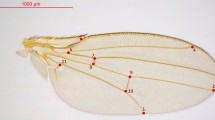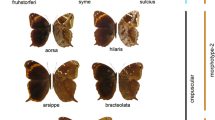Abstract
The phenotypic plasticity of wing size and wing shape of Zaprionus indianus was investigated in relation to growth temperature (17°C to 31°C) in two natural populations living under different climates, equatorial and subtropical. The two populations were clearly distinguished not only by their wing size (the populations from the colder climate being bigger in size), but also by the shape of the response curves to growth temperature i.e., their reaction norms. In this respect, the temperature at which the size of the wing was maximum was about 3°C higher in the equatorial population. Such a difference in size plasticity is already found in two other nonclosely related species, might be a general evolutionary pattern in drosophilids. Wing shape was investigated by calculating an ellipse included into the wing blade, then by considering the ratio of the two axes, and also by analysing the angular position of 10 wing-vein landmarks. For an overall shape index (ratio of the two axes of the ellipse), a regular and almost linear increase was observed with increasing temperature i.e., a more round shape at high temperatures. Wing shape was also analysed by considering the variations of the various angles according to temperature. A diversity of response curves was observed, revealing either a monotonous increase or decrease with increasing temperature, and sometimes a bell shape curve. An interesting conclusion is that, in most cases, a significant difference was observed between the two populations, and the difference was more pronounced at low temperatures. These angular variations are difficult to interpret in an evolutionary context. More comparative studies should be undertaken before reaching some general conclusions.
Similar content being viewed by others
References
Andrewartha H. and Birch L. C. 1954 The distribution and abundance of animals. University of Chicago Press, Chicago.
Angilletta M. J. and Dunham A. E. 2003 The temperature-size rule in ectotherms: simple evolutionary explanations may not be general. Am. Nat. 162, 332–342.
Angilletta M. J., Steury T. S. and Sears M. W. 2004 Temperature growth rate and body size in ectotherms: fitting pieces of a life history puzzle. Integr. Comp. Biol. 44, 498–509.
Araripe L. O., Klaczko L. B., Moreteau B. and David J. R. 2004 Male sterility thresholds in a tropical cosmopolitan drosophilid, Zaprionus indianus. J. Therm. Biol. 29, 73–80.
Atkinson D. and Sibly R. M. 1997 Why are organisms usually bigger in colder environments? Making sense of a life history puzzle. Trends Ecol. Evol. 12, 235–239.
Azevedo R. B. R., James A. C., McCabe J. and Partridge L. 1998 Latitudinal variation of wing: thorax size ratio and wing-aspect ratio in Drosophila melanogaster. Evolution 52, 1353–1362.
Bitner-Mathé B. C. and Klaczko L. B. 1999a Plasticity of Drosophila melanogaster wing morphology: effects of sex, temperature and density. Genetica 105, 203–210.
Bitner-Mathé B. C. and Klaczko L. B. 1999b Heritability, phenotypic and genetic correlations of size and shape of Drosophila mediopunctata wings. Heredity 83, 688–696.
Bubliy O. A. and Loeschcke V. 2005 Variation of life-history and morphometrical traits in Drosophila buzzatii and Drosophila simulans collected along an altitudinal gradient from a Canary island. Biol. J. Linn. Soc. 84, 119–136.
Capy P., Pla E. and David J. R. 1993 Phenotypic and genetic variability of morphometrical traits in natural populations of Drosophila melanogaster and D. simulans. I. Geographic variations. Genet. Sel. Evol. 25, 517–536.
Cossins A. and Bowler K. 1987 Temperature biology of animals. Chapman and Hall, London.
David J. R. and Clavel M. F. 1965 Interaction entre le genotype et le milieu d’elevage. Consequences sur les caracteristiques du development de la Drosophile. Bull. Biol. Fr. Belg. 99, 369–378.
David J. R. and Tsacas L. 1981 Cosmopolitan, subcosmopolitan and widespread species: different strategies within the Drosophilid family (Diptera). C. R. Soc. Biogr. 57, 11–26.
David J. R., Allemand R., Van Herrewege J. and Cohet Y. 1983 Ecophysiology: abiotic factors. In Genetics and biology of Drosophila (ed. M. Ashburner, H. L. Carson and J. N. Thompson), pp. 105–170. Academic Press, New York.
David J. R., Gibert P., Gravot E., Pétavy G., Morin J. P., Karan D. and Moreteau B. 1997 Phenotypic plasticity and developmental temperature in Drosophila: analysis and significance of reaction norms of morphometrical traits. J. Therm. Biol. 22, 441–451.
David J. R., Gibert P. and Moreteau B. 2004 Evolution of reaction norms. In Phenotypic plasticity: functional and conceptual approaches (ed. T. J. DeWitt and S. M. Scheiner), pp. 50–63. Oxford University Press, New York.
David J. R., Gibert P., Legout H., Pétavy G., Capy P. and Moreteau B. 2005 Isofemale lines in Drosophila: an empirical approach to quantitative trait analysis in natural populations. Heredity 94, 3–12.
David J. R., Legout H. and Moreteau B. 2006a Phenotypic plasticity of body size in a temperate population of Drosophila melanogaster: when the temperature-size rule does not apply. J. Genet. 85, 9–23.
David J. R., Araripe L. O., Bitner-Mathé B. C., Capy P., Goñi B., Klaczko L. B. et al. 2006b Quantitative trait analysis and geographic variability of natural populations of Zaprionus indianus, a recent invader in Brazil. Heredity 96, 53–62.
Debat V., Begin M., Legout H. and David J. R. 2003 Allometric and non-allometric components of Drosophila wing shape respond differently to developmental temperature. Evolution 57, 2773–2784.
DeWitt T. J. and Scheiner S. M. 2004 Phenotypic plasticity: functional and conceptual approaches. Oxford University Press, New York.
Garcia-Bellido A., Ripoll P. and Morata G. 1973 Developmental compartmentalisation of the wing disc of Drosophila. Nat. Biol. 245, 251–253.
Gavrilets S. and Scheiner S. M. 1993a The genetics of phenotypic plasticity. 5. Evolution of reaction norm shape. J. Evol. Biol. 6, 31–48.
Gavrilets S. and Scheiner S. M. 1993b The genetics of phenotypic plasticity. 6. Theoretical predictions for directional selection. J. Evol. Biol. 6, 49–68.
Gibert P., Moreteau B., Pétavy G., Karan D. and David J. R. 2001 Chill-coma tolerance, a major climatic adaptation among Drosophila species. Evolution 55, 1063–1068.
Gibert P., Capy P., Imasheva A., Moreteau B., Morin J. P., Pétavy G. and David J. R. 2004 Comparative analysis of morphological traits among Drosophila melanogaster and D. simulans: genetic variability, clines and phenotypic plasticity. Genetica 120, 165–179.
Gilchrist A. S., Azevedo R. B., Partridge L. and O’Higgins P. 2000 Adaptation and constraint in the evolution of Drosophila melanogaster wing shape. Evol. Dev. 2, 114–124.
Gilchrist A. S. and Partridge L. 2001 The contrasting genetic architecture of wing size and shape in Drosophila melanogaster. Heredity 86, 144–152.
Hoffmann A. A. and Parsons P. A. 1997 Extreme environmental change and evolution. Cambridge University Press, London.
Hoffmann A. A. and Shirriffs J. 2002 Geographic variation of wing shape in Drosophila serrata. Evolution 56, 1068–1073.
James A. C., Azevedo R. B. R. and Partridge L. 1997 Genetic and environmental responses to temperature of Drosophila melanogaster from a latitudinal cline. Genetics 146, 881–890.
Karan D., Munjal A. K., Gibert P., Moreteau B., Parkash R. and David J. R. 1998 Latitudinal clines for morphometrical traits in Drosophila kikkawai: a study of natural populations from the Indian subcontinent. Genet. Res. 71, 31–38.
Karan D., Moreteau B. and David J. R. 1999 Growth temperature and reaction norms of morphometrical traits in a tropical drosophilid: Zaprionus indianus. Heredity 83, 398–407.
Karan D., Dubey S., Moreteau B., Parkash R. and David J. R. 2000 Geographical clines for quantitative traits in natural populations of a tropical drosophilid: Zaprionus indianus. Genetica 108, 91–100.
Klaczko L. B. and Bitner-Mathé B. C. 1990 On the edge of a wing. Nature 346, 321.
Leather S., Walker K. and Bale J. 1993 The ecology of insects over-wintering. Cambridge University Press, Cambridge.
Loeschcke V., Bundgaard J. and Barker J. S. F. 2000 Variation in body size and life history traits in Drosophila aldrichi and D. buzzatii from a latitudinal cline in eastern Australia. Heredity 85, 423–433.
Loh R. and Bitner-Mathé B. C. 2005 Variability of wing size and shape in three populations of a recent Brazilian invader, Zaprionus indianus (Diptera: Drosophilidae), from different habitats. Genetica 125, 271–281.
Machado T., Solé-Cava A. and David J. R. and Bitner-Mathé B. C. 2005 Allozyme variability in an invasive drosophilid, Zaprionus indianus (Diptera Drosophilidae): comparison of a recently introduced Brazilian population with old world populations. Ann. Soc. Entomol. Fr. 41, 7–13.
Matta B. P. and Bitner-Mathé B. C. 2004 Genetic architecture of wing morphology in Drosophila simulans and an analysis of temperature effects on genetic parameter estimates. Heredity 93, 330–341.
Morin J. P., Moreteau B., Pétavy G. and David J. R. 1999 Divergence of reaction norms of size characters between tropical and temperate populations of Drosophila melanogaster and D. simulans. J. Evol. Biol. 12, 329–339.
Pigliucci M. 1996 How organisms respond to environmental changes: from phenotypes to molecules (and vice-versa). Trend Ecol. Evol. 11, 168–173.
Pigliucci M. 2001 Phenotypic plasticity: beyond nature and nurture. Johns Hopkins University Press, Baltimore.
Precht H., Christophersen J., Hensel H. and Larcher W. 1973 Temperature and life. Springer, Berlin.
Prevosti A. 1955 Geographical variability in quantitative traits in populations of D. subobscura. Cold Spr. Harb. Symp. Quant. Biol. 20, 294–299.
Schlichting C. D. and Pigliucci M. 1993 Control of phenotypic plasticity via regulatory genes. Am. Nat. 142, 366–370.
Sokal R. and Rohlf F. J. 1995 Biometry, 3rd edition. W. H. Freeman and Company, New York.
Sokoloff A. 1965 Geographic variation of quantitative characters in populations of Drosophila pseudoobscura. Evolution 19, 300–310.
Stalker H. D. and Carson H. L. 1947 Morphological variation in natural populations of Drosophila robusta Sturtevant. Evolution 1, 237–248.
Starmer W. T. and Wolf L. L. 1989 Causes of variation in wing loading among Drosophila species. Biol. J. Linn. Soc. 37, 247–261.
Thompson J. N. 1975 Quantitative variation and gene number. Nature 258, 665–668.
Thompson J. N. and Woodruff R. C. 1982 Polygenic analysis of pattern-formation interdependence among veins in the same compartment of the Drosophila wing. Genetica 60, 71–76.
Van’t Land J., Van Putten P., Zwaan B., Kanping A. and Van Delden W. 1999 Latitudinal variation in wild populations of Drosophila melanogaster: heritabilities and reaction norms. J. Evol. Biol. 12, 222–232.
Weber K. E. 1992 How small are the smallest selectable domains of form. Genetics 130, 345–353.
Wilkinson L. 1997 Systat for Windows, version 7.0. SPSS, Chicago.
Yassin A., Capy P., Madi-Ravazzi L., Ogereau D. and David J. R. 2007 DNA barcode discovers two cryptic species and two geographical radiations in the invasive drosophilid Zaprionus indianus. Mol. Ecolo. Res. 8, 491–501.
Author information
Authors and Affiliations
Corresponding author
Rights and permissions
About this article
Cite this article
Loh, R., David, J.R., Debat, V. et al. Adaptation to different climates results in divergent phenotypic plasticity of wing size and shape in an invasive drosophilid. J Genet 87, 209–217 (2008). https://doi.org/10.1007/s12041-008-0034-2
Received:
Accepted:
Published:
Issue Date:
DOI: https://doi.org/10.1007/s12041-008-0034-2




